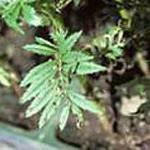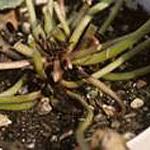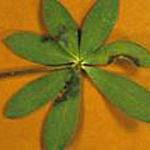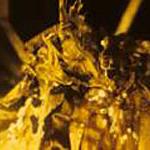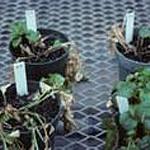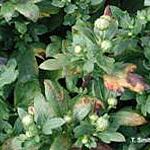Leaf Spot Diseases of Floricultural Crops Caused by Fungi and Bacteria
Leaf spot diseases caused by fungi and bacteria are among the most commonly encountered problems for ornamental growers. Many different crops are affected by species of the fungal genera Alternaria, Cercospora, Colletotrichum (anthracnose), and Myrothecium. Bacterial leaf spots are most commonly caused by pathovars of Pseudomonas syringae and Xanthomonas campestris. The aforementioned are just a small subset of the many pathogens that may cause leaf spot diseases. Downy mildews (Downy Mildew Diseases of Ornamental Plants) and Rust diseases (Rust Diseases of Ornamental Plants) are covered in other facts sheets.
Common Fungal Leaf Spot Pathogens
Alternaria alternata
This fungus has a wide host range including geranium, Dahlia hybrids, Gerbera jamesonii (African daisy), Begonia species, Gardenia augusta, Cineraria, Verbena, African violet, Hibiscus, and Vinca. Small water soaked lesions (spots) first appear on lower, older leaves. As the lesions mature, they become sunken and turn brown, sometimes with a yellow halo. The lesions may or may not appear to have concentric rings. In severe cases lesions can coalesce, causing leaf chlorosis and drop. Alternaria leaf spots are favored by conditions that stress host plants such as high or low temperatures or closed boxes during shipping.
Cercospora species
Cercospora leaf spots have been reported occasionally on Dahlia hybrids, Poinsettia, Lisianthus, Gardenia augusta , Gerbera jamesonii (African daisy), Hibiscus, pansy, Kalanchoe, Verbena, and geranium. Lesions first appear as light green sunken spots which turn gray and darken with the production of spores. They may also have a purple border, and appear to be raised in the center. Lesions may coalesce into V-shaped necrotic areas which can be confused with bacterial blight. Heavily infected leaves may drop.
Colletotrichum species (anthracnose )
Anthracnose diseases are caused by species of Colletotrichum and Gloeosporium. Many plants are susceptible, including Anemone coronaria, Begonia species, Vinca, Cyclamen persicum, Dahlia hybrids, Poinsettia, Gardenia augusta, Hibiscus, geranium, Primula hybrids, Ranunculus, Verbena, and Gloxinia. On Anemone grown outdoors , Colletotrichum causes a severe disease known as leaf curl. Leaf margins curl down and both petioles and pedicels become exceptionally twisted.
Growth distortions may be followed by shoot dieback, stem splitting, and the failure of young leaves to expand. Small, brown lesions may be seen on petioles and pedicels. Anthracnose on Cyclamen causes small, round, brown leaf spots, stunting, deformity, and necrosis of immature petioles and pedicels at the center of the plant. Vascular discoloration is evident in the infected petioles and corm. On other hosts, Colletotrichum occurs mainly as small, round lesions on leaves and petals which coalesce to form large areas of necrotic tissue. Leaves and petals may become completely blighted. A diagnostic sign for anthracnose is the presence of pink to orange sporulation oozing from lesions under close inspection. Anthracnose diseases can be spread on infected seed or rhizomes, as a saprophyte in injured tissue, or originate from infected native plants.
Myrothecium roridum
Myrothecium is a common, soil borne saprophyte that is considered a weak pathogen which invades wounded or stressed plant tissue under favorable environmental conditions. It has been reported on Gardenia augusta , New Guinea Impatiens, Begonia species, and Gloxinia, and can cause serious losses in pansy. Symptoms on pansy include chlorosis, stunting, poor plant vigor, wilting, and plant collapse. It can also cause root and crown rot on some plant species, and may cause loss of cuttings during propagation. Lesions are often target-like, with light brown centers and dark margins. Distinctive dark green to black sporodochia (spore-producing structures) edged by white hyphae form in the lesions. The disease is favored by temperatures between 65°-68° F, high humidity, plant injury, and excessive fertilization. Promoting rapid wound periderm formation by high temperatures can help to manage the pathogen.
Bacterial Leaf Spot Diseases
Bacteria are microscopic, single celled organisms that reproduce rapidly and cause a variety of plant diseases including leaf spots, stem rot, root rots, galls, wilt, blight and cankers. They survive in infected plants, debris from infected plants, on or in seed, and in a few cases, infested soil. They are easily moved from soil to leaves and from leaf to leaf by splashing water, tools, and worker's hands. Most bacteria require a wound or natural entry to infect plants and thrive in warm, moist environments. The single best way to prevent bacterial diseases is to purchase plants certified to be free of pathogens by the process of culture indexing. Pieces of plant tissue are incubated in a nutrient solution and if no plant pathogens grow after the procedure is repeated 2-3 times, the plant is said to be pathogen free. Procedures for handling soil and infected plant debris should be separated from plant handling operations.
Pseudomonas syringae
P. syringae has a wide host range including woody species, vegetables, grasses, and herbaceous ornamentals; however, there are numerous strains (pathovars) of the bacterium, and these are generally very specific to one or a small group of host plants. Reported hosts include geranium, Dahlia hybrids , Hibiscus, Impatiens walleriana, and New Guinea Impatiens. Symptoms of disease are water-soaked lesions which become dark brown, black, or tan. Infected tissue becomes papery and cracks as the leaf expands, resulting in distortion of leaves. Lesions are often accompanied by yellowing of adjacent tissue and death of leaves without wilting. P. syringae may be seed-borne in some crops and is favored by low temperatures.
Pseudomonas cichorii
P. cichorii causes symptoms similar to those of P. syringae on Gerbera jamesonii, Hibiscus, Impatiens wallerana, Cyclamen persicum, primrose, Vinca chrysanthemum, Florist's geranium and many other ornamental crops and foliage plants. This bacterium is favored by high temperatures and can survive epiphytically (on top of plants) on chrysanthemums and other hosts, allowing widespread dispersal on plant material.
Xanthomonas campestris
Like P. syringae , X. campestris affects many plant species, but exists as pathovars that are host specific. Important hosts include Begonia species, Poinsettia, and Capsicum annuum (ornamental pepper). On Begonias , symptoms vary according to species or interspecific cross. Wax begonias and tuberous begonias (nonstop) exhibit small circular lesions with a translucent halo, leaf drop, and wilt if the bacteria become systemic. Rieger begonias display large, brown, wedge shaped lesions, often at leaf margins, which display a characteristic stippling. Species, cultivars, and hybrids of Begonia vary in susceptibility to this disease. On Poinsettia, symptoms of X. campestris first appear as gray to brown, water-soaked lesions on leaf undersides. As lesions enlarge, they become apparent on the tops of leaves as brown to rust colored lesions, with or without a pale green halo. Lesions may coalesce to large areas of blighted tissue and leaves may yellow and drop. This disease spreads rapidly. The bacterium probably exists epiphytically making colonized, non-symptomatic cuttings the source of epidemics. Vegetable transplants, including tomato, pepper, and cole crops are also susceptible to pathovars of X. campestris.
Management of leaf spot diseases
Good sanitation practices and reduction of humidity in the greenhouse and around plants are essential to the management of leaf spot diseases.
- Purchase plants from a reputable source.
- Always check incoming plants carefully for signs and symptoms of disease, and do not bring diseased plants into the greenhouse.
- Regardless of the pathogen involved, management should involve decreasing the relative humidity in the greenhouse and within the plant canopy.
- Minimize leaf wetness by watering early in the day or sub-irrigating. Eliminate overhead watering if possible.
- Provide good air circulation within the plant canopy by proper plant spacing and the use of fans to provide horizontal air flow.
- Remove and destroy any heavily infested plants.
- Diseased plant debris should be promptly removed from the growing area. Benches should be cleaned with a labebed disinfectant.
- Workers should wash their hands frequently and immediately after handling infected plants or soil.
- Avoid handling plants when they are wet.
- Tools should be frequently disinfected.
- Grow resistant cultivars when they are available.
- Do not re-use growing media or pots.
- Do not hang baskets directly over benches full of potted plants.
- Nutrition may affect disease susceptibility; avoid excess or insufficient fertilization.
- Fungicides are best used preventatively. There are many broad-spectrum fungicides with wide crop clearance which will control most fungal leaf spots. These include axoystrobin, chlorothalonil, mancozeb, mylobutantil, pyrclostrobin, thiophanate-methyl, and copper products. Follow label directions carefully.
- Bactericides such as copper products cannot cure diseased plants, but may help prevent uninfected plants from becoming infected.
Note that while cultural management techniques for both fungal and bacterial leaf spots are similar, chemical management is very different. In addition, leaf spots may also be caused by viruses. When making management choices it is critical to have an accurate diagnosis, which can be difficult to arrive at without the use of a microscope. Samples may be sent to a diagnostic lab for diagnosis. For information on the University of Massachusetts Plant Diagnostic Lab, please see http://ag.umass.edu/services/plant-diagnostics-laboratory.
References
- Pearce, Mila. 2005. Pansy Diseases in the Landscape. University of Georgia College of Agricultural and Environmental Sciences. UGA Extension publications
- Daughtrey, M.L. Wick, R.L., and J.L. Peterson. 1995. Compendium of Flowering Potted Plant Diseases. APS Press. St. Paul , MN . 90 pp.
- Moorman, Gary. 2005. Bacterial Diseases of Ornamental Plants. Penn State University Cooperative Extension.
Photos by Dr. Robert L. Wick
